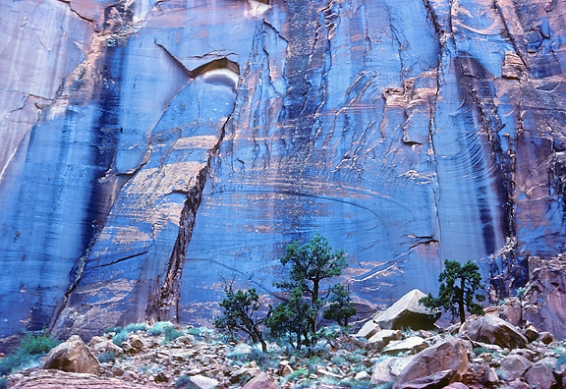My friend, Pastor Jeff Louden, asked me to post an entry on his Landscapes of Faith blog. (We are both on the board of Utah Interfaith Power & Light.) And so I become an emissary from the canyons of southern Utah to the world of the Lutherans! (perhaps I’ll run into Garrison Keillor…) I chose an excerpt from my essay in West of 98: Living and Writing the New American West, the fine anthology edited by Lynn Stegner and Russell Rowland and published by the University of Texas last year. I’ll reprint the entry here, as well.
In the long-ago spring of 1976, the side canyons of Utah’s Escalante River were more remote than they are now, and they are still pretty remote. My two buddies and I had driven without incident in our hand-me-down family sedans across the Circle Cliffs to the Moody Creek trailhead. We found no other vehicles parked at the end of the road. Once we set off on foot, we weren’t expecting to see anyone else for the next week.
We made camp at the junction of East Moody Canyon and the Escalante. In the lengthening iridescent light of late afternoon we wandered up East Moody Canyon. Each rounding curve brought new walls. Desert varnish streaked the crossbedded sandstone, black swaths across lavender and vermillion. Here, the color fields of Rothko; there, the bold strokes of Franz Kline.
One wall in particular drew me. I moved my tripod this way and that, aiming my camera past piñons and junipers to a canyon wall reflecting purples and mauves, textured with fractures and cracks. The light had bounced down between canyon walls from the sky and the stars, distilled to an unbelievable saturation. I had never seen such surreal and intense colors. Later, I realized Philip Hyde had photographed the very same wall for Slickrock and for his Glen Canyon portfolio. Over the years as I published my pictures of that place, I captioned them “Hyde’s Wall.”
We tore ourselves away from each mosaic of rock, tree, grass, and lichen in the endlessly changing gallery and strolled on, tantalized always by the next bend. We came to an amphitheater, the canyon’s curves arranged to form an echo chamber with three reflective surfaces.
A trickle of water in the streambed was enough for the frogs and toads. On that springtime evening they were calling enthusiastically, the cricketlike trill of red-spotted toads and the plaintive bleat of Woodhouse toads advertising their readiness for sex. Spadefoot toads added a third melodic line, a sawing snore, while the final accent came from the ratchety bark of the canyon treefrog—my favorite. They took turns, calling across the alcove, each song echoing individually and distinctly. Stage right, stage left. Then a pause, and a call from back in the cheap seats. We kept our distance to avoid silencing them. They created a fully three-dimensional audio space, and to lie back against a boulder and listen to them felt both intimate and voyeuristic.
Today, fewer and fewer canyon treefrogs call from potholes and desert streams. The Colorado River Basin lies squarely within the crosshairs of global climate change. Rising average temperatures are certain to bring warmer summers, more rain than snow, decreased spring runoff, and more frequent wildfires. Climate change will push every living community uphill until alpine tundra and alpine animals like pikas can retreat no higher and will be pinched right off the mountaintops of the southern Rockies. What will we do for water in this increasingly dry century?
Our edges are rounder, our destination closer. Gravity and time turn out to be equally inexorable. This same arc through time deepens our relationships with the places we love. The redrock wilderness has granted us refuge, repeatedly. The universe has provided us with a lifetime of chances to speak up for these remaining fragments of wild ecosystems.
Let’s take full advantage of these last few winding and glorious bends, missing no opportunity for joyful adventure and rising to each occasion calling for advocacy as we tumble toward the sea.
[Excerpted from “Tumbling Toward the Sea” by Stephen Trimble, in West of 98: Living and Writing the New American West. Lynn Stegner and Russell Rowland, editors. University of Texas Press.]
